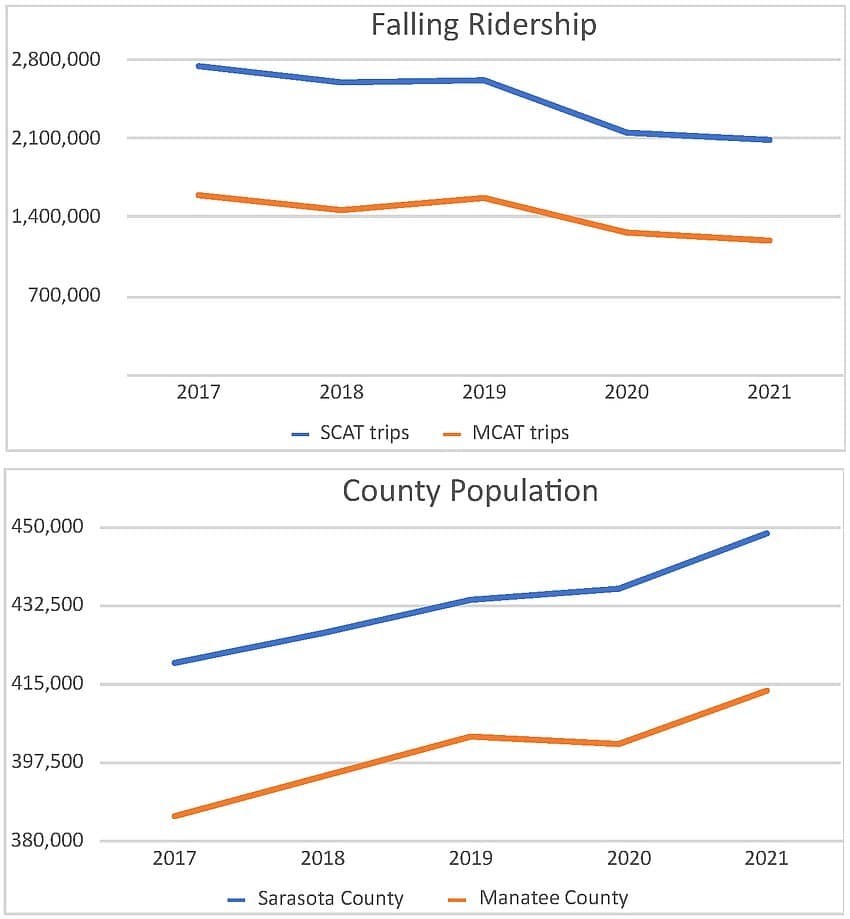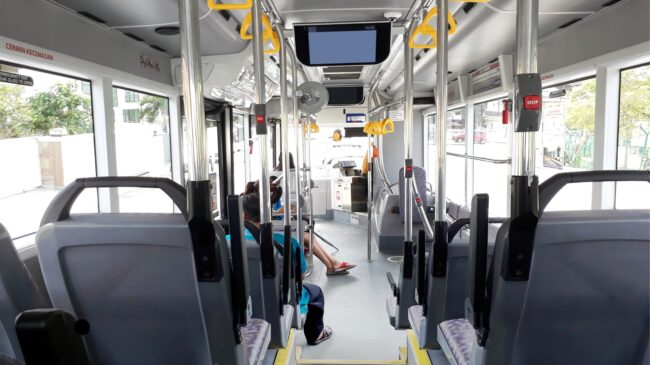These are trying times for transit agencies across the United States, and Sarasota County Area Transit and Manatee County Area Transit are no exceptions. As the accompanying charts show, ridership on both county bus systems was falling, despite population growth in the areas, even before the COVID-19 pandemic decreased ridership worldwide. Transit ridership in Sarasota and Manatte fell more during the pandemic and shows little signs of recovery today. This is a real problem when both counties plan on increasing transit use.
Across the nation, most transit agencies are facing anemic ridership and spiraling budget deficits as they grapple with post-COVID travel patterns. Most transit agencies face a fiscal cliff next year when supplemental COVID funding ends. For Sarasota County Area Transit (SCAT), the drop in federal funding could be over $5 million, around 40% of its annual operating costs, while for Manatee County Area Transit (MCAT), the financial hit will be smaller but still significant.
Yet, rather than steering their county transit systems in a new direction, both agencies are largely hewing to a strategy of doing more of what hasn’t worked in the past. While there are some commendable experiments with new transit service offerings, such as the Breeze trolley and dial-a-ride services, more innovation is needed to adjust to new transit realities for workers and tourists.
Without major changes, SCAT and MCAT will either need major increases in local funding or steep service cuts. Local service cuts would harshly affect transit-dependent riders (those without access to a vehicle). Many of these transit-dependent riders have no other way of getting to their jobs, leading to lost jobs and economic activity for families and the local economies.
But, increasing county tranist budgetscomes with significant tradeoffs. What other government services would have to be cut to free up money to sustain public transit?

Fortunately, there are five actions that SCAT and MCAT can take to increase tranist ridership, reduce financial pain, and improve their long-term sustainability.
First, the counties should fully fund bus service for transit-dependent riders. Over the past 30 years, too much focus has been on providing transit service for transit-choice riders (those with access to automobiles). This is partly due to both counties’ goals of increasing ridership. Transit agencies have to attract choice riders if they want to increase the total percentage of trips taken on transit. However, very few transit agencies across the nation have found a way to increase choice rider transit use, even with large increases in their expenditures.
Instead, transit agencies in Sarasota and Manatee need to focus on their core bus customers. The best way to grow ridership is to provide more reliable bus service that comes more frequently, ideally every 15 minutes. Houston provides a model for other cities. Led by transit consultant Jarrett Walker, ridership in Houston grew by up to 20%. The bus service redesign also made the system more fiscally sustainable.
Second, transit fares are far below the cost of providing the ride. For transit-dependent riders, this makes sense, but for choice riders, even the full cost of a bus ride is less than the cost to drive, including fuel, depreciation, tolls, and parking. In many communities, the cost to drive alone is about eight times as much as even a full-cost transit fare. Cost savings don’t work to attract choice riders, so transit agencies should stop trying. Instead, transit agencies should focus on providing appealing, reliable, pleasant service that riders might sometimes choose over driving. Expanding bus passes for students and similar programs that focus on transit-dependent riders will allow continued low fares for those users. Special passes for tourists could also be an option to help increase their use of buses rather than driving and parking at local attractions.
Third, SCAt and MCAT should replace low ridership bus routes with paratransit or on-demand rideshare options. Not every Sarasota and Manatee transit route has the ridership to justify a 40-foot fixed-route bus. In many cases, variable-route, on-demand transit service is a better, more cost-effective option. Sarasota County has Breeze on-demand service, but it could be expanded further. Several cities have experimented with partnerships with ridesharing services like Uber and Lyft and found the cost of providing rides on those services for the same as a bus fare can be a bit less than running a bus service on sparse routes.
Fourth, the counties should look to contract out bus service. In Europe, Asia, and some U.S. cities, bus services are contracted out to national bus transit companies. The two most significant advantages of contracting are more flexible, targeted services, and lower costs. Contractor service is evaluated on performance-based criteria and focuses on how happy the service makes customers. Costs are lower because economies of scale eliminate the duplication of many management functions. Contracting brings accountability. If the private entity does not abide by the contract terms, the public agency can fine the contractor or cancel the contract. If the contractor produces exceptional service, the public agency can reward it. When the public agency provides the service itself, there is little incentive to improve the service because the agency is unlikely to punish itself for failings and cost-overruns.
Fifth, SCAT and MCAT can make greater use of intelligent transportation systems (ITS). There are many ITS features, including transit priority for signalized intersections, electronic message boards, sophisticated real-time apps, and variable bus information systems. Each of these systems can improve the passenger experience at minimal costs. For example, traffic signal prioritization has been proven to reduce delays by 20% on bus rapid transit lines. However, many bus systems only use traffic signal prioritization when they are behind schedule. Traffic signal prioritization should always be used to keep buses on schedule. Transit agencies should not wait until they are behind schedule to utilize valuable tools.
A change in focus based on best practices in public transit could help SCAT and MCAT be more successful at what transit should be bood at—providing mobility for people who don’t have other transportation options. That is a much more solid foundation for the future of transit in Sarasota and Manatee than continuing to hope that people will decide to use transit rather than drive. Too many U.S. transit agencies have been trying that for decades, and it hasn’t worked yet.
A version of this commentary first appeared in the Sarasota Observer.


